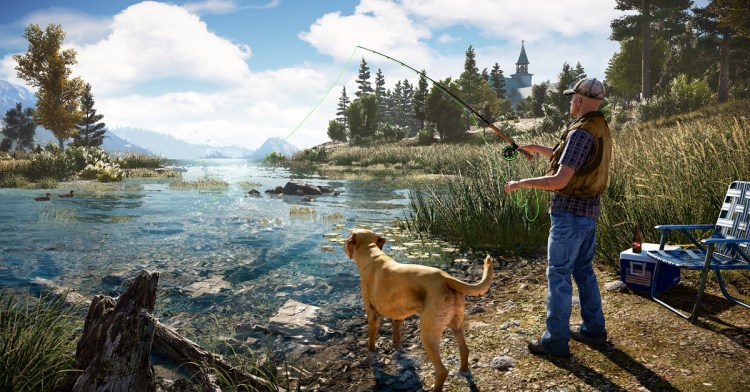Dan Hay, creative director of Ubisoft’s Far Cry 5, said that the Far Cry franchise is always about the combination of chaos and beauty. His team chose to set the next game — coming February 27, 2018 — in the beautiful fictional Hope County in Montana. Beneath that beautiful surface, a frightening religious cult runs the region, and your job as a player will be to organize the resistance against that cult.
The story is about American extremism, and it is no coincidence that the fears it generates come straight out of the headlines of current events. Hay wanted to convey what it was like to grow up with a sense of dread and a feeling of “us and them.” And that’s what he has created in the story of Far Cry 5. His team traveled to Montana to get a sense of the place, and they envisioned what would happen to it if an armed militia came into conflict with those who won’t leave it alone.
Fans like our own Jeff Grubb guessed the story after the company teased the story with videos and a picture this week. But today the company peeled back many more of the details about Joseph Seed, the villain and cult leader who lures people in with his charisma and anti-government rhetoric. Ubisoft has created a chilling premise for a an open-world game that, at least in the past, is more like a theme park for first-person shooter fans. I felt a lot of dissonance as I heard the dramatic story and pictured how it would fit in with the usual Far Cry silliness.
I sat down with Hay and talked about that. Here’s an edited transcript of our interview.
June 5th: The AI Audit in NYC
Join us next week in NYC to engage with top executive leaders, delving into strategies for auditing AI models to ensure fairness, optimal performance, and ethical compliance across diverse organizations. Secure your attendance for this exclusive invite-only event.

Above: Far Cry 5 creative director Dan Hay.
GamesBeat: You have an interesting choice of location in Far Cry 5. How did you get there?
Dan Hay: It was one of those things where we put it in the back of our heads for a while. When I was talking before — we knew we wanted to go to the States for a long time. We’d been kicking the idea around. We went over the different possibilities and situations. Then we started talking about what Far Cry is at its roots, which is taking you to a frontier. We looked at Montana and said, “You know what? This is interesting.”
We started to look up stories from Montana and do research on it. What was interesting about what we came up with — the feeling we got from there is that people didn’t trust the government. They wanted to be left alone. They went there to be able to live their lives the way they wanted to live them. They were truly interesting people. Far Cry people. We went there and met them, and we wanted to validate that experience. Within 24 hours we knew. It’s a place I would want to retire to, to be honest. It’s super cool. It’s beautiful.
When you think about what it takes to build a Far Cry experience, you want to be able to have something that’s a frontier, something that’s beautiful, something that’s evocative, and you want to fill it with unique characters and unique experiences. Then you want to allow the player to go out and meet these different characters, have these different toys. When we were in Montana we were surrounded by all of that. It just felt right.
GamesBeat: Did it take you back to iconic characters like Vaas (the villain from Far Cry 2)?
Hay: We kept running into really unique characters, really unique people in the world, who had incredible stories. When we think about Far Cry, and the idea that reality is far stranger than fiction—that’s something we say over and over again as we work on the game. I think about Far Cry being, you’re sitting in a bar, having a drink, and you hear a story being told by two people next to you. You want to get the concentration of that story to be really interesting.
When we were in Montana, the number of stories and the number of people — just the weird shit we heard, it was unbelievable. It was super cool. Honestly, we felt like we were there for an incredibly short amount of time before we realized it was the perfect setting for Far Cry.
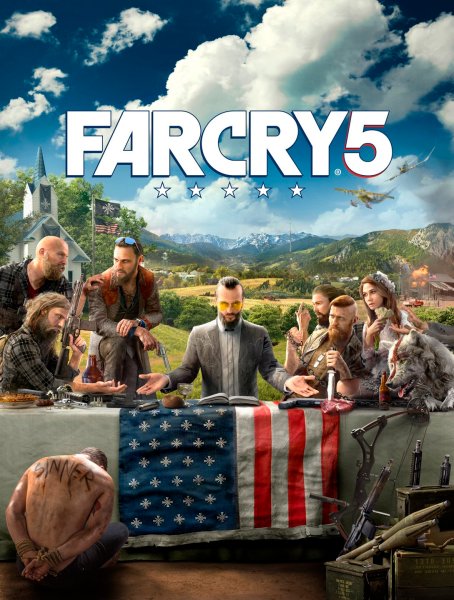
Above: Big cry country.
GamesBeat: You’re also dealing with an uncomfortable topic. It feels like this is right in your back yard. It’s a potentially very dangerous place, and it’s real.
Hay: I think that a lot of us — we’ve been camping, or we’ve traveled through regions that are like that. What makes it feel that much more wonderful and strange, you take something that’s normal and just twist it a little. But it’s something you think you know. Then, when you scratch at it a bit, you realize it’s not what you thought it was.
GamesBeat: When I was watching the preview, I got some of the same eerie feeling I got from Watch Dogs 2. Coming from San Francisco and seeing San Francisco in a game, you recognize how much of this looks so real. Have you learned from something like that for this project?
Hay: Sure. If you’re building a game and you’re in the same region and talking to the same people, and maybe you even have team members who were on those other games, you can’t help but get some cross-pollination and different ideas. But what’s really cool about what we got for Far Cry is that the characters we have in the world, the people we have in our world, have really unique stories. I think that when we’re trying to build a rich world, there are lessons to be learned from a bunch of different games out there. But in this game what we’ve managed to build and pull off is very convincing characters with real lives.
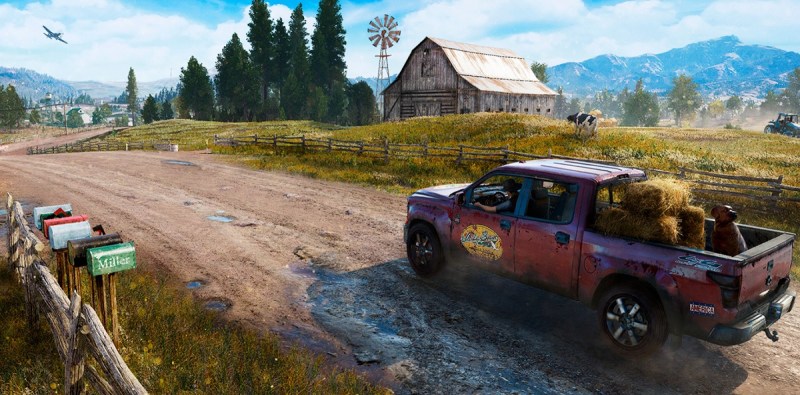
Above: Hope County, Montana, is the setting of Far Cry 5.
GamesBeat: World-building seems to be one of Ubisoft’s core strengths, after Watch Dogs and The Division and now this. Does the research that has to go into that ever make you uncomfortable, though?
Hay: Life is not perfect. Life isn’t always idyllic. There are moments of beauty and moments of being comfortable. So for sure, when we do some of our research, we hear stories that are strange. We hear stories that are wonderful. We hear stories that are horrible. We are selective with what we tackle and what we look at. We want you to meet characters that are intriguing, that challenge you, that tantalize you a bit, and that you’re going to remember.
GamesBeat: Is this feeling that we’re sitting on the edge of a cliff, something very dangerous — it feels somewhat like the Cold War, somewhat like 9/11. It’s a precarious point.
Hay: What was interesting, and why we built a cult — it was super interesting to have a character that was talking about this feeling that he had, that a calamity was going to come. You look at the potential in this. There have been a number of times that we could all believe that a calamity was about to occur. We’ve almost been desensitized to it.
I come back to the story of the guy wearing a sandwich board about the end of the world. Two years ago, when I was looking at this, I ran into that guy walking downtown, saying it was the end of the world. He had that sandwich board on, saying the same thing. For the first time in my life I looked at him and thought, “Well, maybe he knows something we don’t.” It’s interesting to see that in our game, as a feeling, but also reflected a bit in our real world.
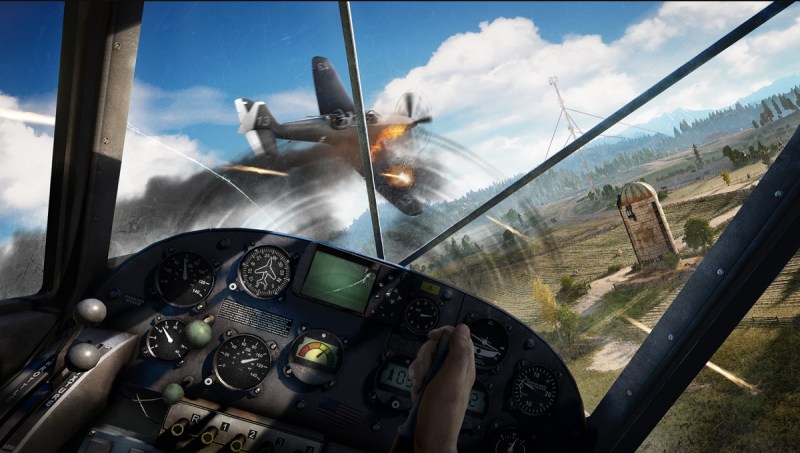
Above: Far Cry 5 will still have a lot of Far Cry style combat, including fighting in the air.
GamesBeat: Watch Dogs 2 had a lighter tone. There was an opportunity to have very believably funny things happening there. This one sounds much more serious. Do you want to have some of the same frivolity that’s popped up in Far Cry games?
Hay: We want to make sure that the world is ripe for you to be able to snack on the experience the way you want to snack on it. There’s no question that we — you go back to building Vaas, building tough characters, unique characters. We’re building bad guys. They’re going to do bad things, to make it feel like it’s relevant in the U.S. and make it feel like it makes sense in that space. But at the same time, you’re going to meet people in the world who are a little bit off. You’re going to have toys in the world. You’re going to have different experiences. There will be different flavors throughout the game for you to be able to snack on and build your own experience.
GamesBeat: But you don’t want it to quite be Just Cause 3, I suppose.
Hay: When you think about the tone and what we’re building, we want it to feel as real as we can. We’re building entertainment. We want people to be entertained. We want to make it feel real, and we want to make it feel like it has consequence. But at the same time, sometimes you want to just go blow shit up. That’s okay.
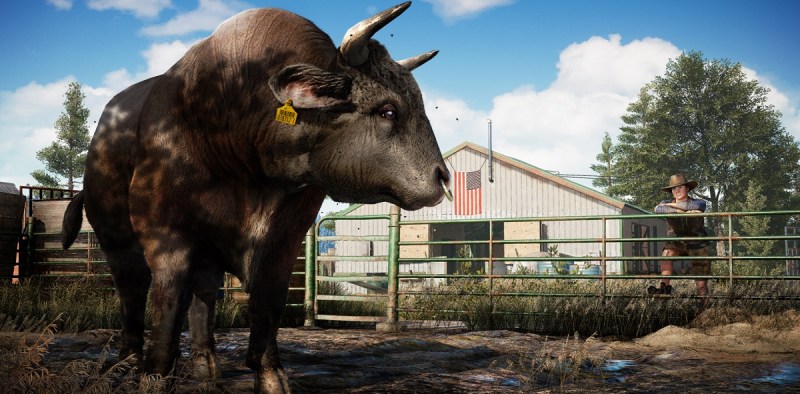
Above: Even the beasts look beautiful in Far Cry 5.
